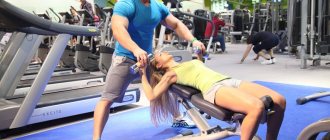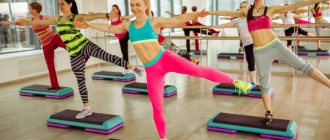Aerobic training[edit | edit code]
The influence of aerobics on the level of visual attention of students ( 1 point
- before performing the load;
2 point
- immediately after the load;
3 point
- 45 minutes after the load)
Aerobic training (training, exercises), aerobics, cardio training
is any type of physical activity that uses many muscles and consumes large amounts of oxygen.[1] Aerobic exercises are performed at low to moderate intensity and are dynamic, continuous and long-term (more than 5 minutes), which is accompanied by a high heart rate and rapid breathing.
Typical aerobic workouts are running, walking, swimming, cycling, dancing, active games, etc.
Aerobic endurance primarily depends on the functional state of the cardiovascular system, which ensures the supply of oxygen and nutrients to the muscles.[2] Therefore, aerobic training is also called cardio training, and aerobic endurance is also called cardiovascular endurance[3].
Aerobic training zone
can be calculated based on the maximum heart rate (MHR) using the formula for men: 220 – age; for women: 226 – age. Aerobic mode assumes 70-80% of MHR.
From a biochemical point of view, aerobic exercise is a type of physical activity in which muscle movements are performed using the energy obtained during aerobic glycolysis, that is, the oxidation of glucose with oxygen.
Aerobic training
designed to increase the body's endurance, tone up, strengthen the cardiovascular system and burn fat.
Yuzhakov Anton Aerobic training
However, it should be remembered that systematic scientific research has not been carried out. This conclusion was rather based on the conclusion that during aerobic exercise, energy consumption increases slightly. This ignores the fact that most of the daily intake is basal metabolism, which slows down after aerobic exercise stops. This is due to the fact that the body requires resources to restore what has been lost. Moreover, the more energy stored in fat cells is spent, the more the body will try to compensate for the losses, storing for future use and slowing down metabolism. In order for the negative consequences of aerobic exercise to be minimal, you will have to limit your daily calorie intake, and when your daily calorie intake is reduced too much, the body begins to increase the number of fat cells. Thus, aerobic exercises should be used carefully and thoughtfully, taking into account the negative consequences of their use. The paragraph consists of dubious, unsubstantiated statements!
Aerobic exercise has also been shown in research to cause muscle hypertrophy.[4]
A 2014 study by Michele Tine found that a single 12-minute bout of aerobics caused significant improvements in students' visual perception and attention immediately after exercise and 45 minutes later, which in turn improved their academic performance.[5]
American researchers from the University of California estimated the amount of energy expended by men and women who remained fit and active at 60 or 70 years of age. It turned out that older people who regularly ran spent the same amount of energy walking as 20-year-old teenagers. Regular walks did not have this effect. These people spent 20% more energy walking.[6]
How to combine loads
It cannot be said that both types of training can be found, as they say, in their pure form. It can be difficult to separate the two training options. For example, if you drag out an anaerobic exercise for more than 15 seconds, it is already called aerobic. That’s why experts recommend training in a comprehensive manner: you do both types of exercises. They can be combined in different ways, but certain principles should still be followed.
Let's look at a specific example. Usually the scheme is as follows: 30-40 minutes of aerobic training, and then strength (anaerobic exercises) for 15-20 minutes. But do not think that such a scheme is ideal. It occurs more often, yes, but it still cannot be called optimal. Therefore, do aerobic and anaerobic training on different days. This approach will not overload the muscles and will allow you to see the result.
That is, you have an alternative:
- Option 1. 15-20 minutes of oxygen loads after a full strength training.
- Option 2. Do aerobic exercises for no longer than 13 minutes as a warm-up before a full strength training session.
- Option 3. You conduct oxygen and oxygen-free training on different days according to your given program.
The third option is optimal. You don’t mix load options; it’s even easier for the brain to focus on one task. If you are serious about taking care of your body, losing weight, strengthening your body, then you should train 5 times a week. You can have 6, but not everyone is so organized. What percentage of aerobic exercise is you decide for yourself. This can be a 3:2 ratio (oxygen/oxygen-free).
Be sure to read: What should fitness be like for weight loss, as well as other tips
If one day you forgot/didn’t have time/were too lazy to do aerobics or Pilates, but took a nice walk, you can count the long walk as an aerobic workout.
Aerobic exercise[edit | edit code]
The term “cardiovascular” or “aerobic” exercise refers to a type of physical activity that is of significant duration, is a combination of movements of a large number of muscles and other body systems, and is usually accompanied by an increased heart rate. Examples include walking, running, cycling, swimming and cross-country skiing. The word “aerobic” literally means “absorbing air.” This directly points to the role of oxygen in the oxidation (“burning”) of carbohydrates and fats to produce adenosine triphosphate, the main form of energy used in cellular reactions. The benefits of aerobic training include improving heart and lung function, lowering blood pressure, activating metabolism, strengthening the immune system, increasing self-esteem and stress resistance. This type of exercise is one of the most important components of maintaining health and vitality. To choose the right type and level of aerobic activity, and to make exercise as safe and effective as possible, you should be guided by the following principles and concepts.
Why you shouldn’t get carried away with just one type of load
The benefits of changing loads
It’s not even a matter of harmoniously strengthening the body (although this is important). Aerobic exercise itself will only be effective for naturally thin people. If you are generally prone to excess weight, then after intense aerobic exercise your body will urgently need fat reserves. After all, during oxygen training, it is actively spent, it is its fuel. Getting used to regular aerobic exercise, the body looks for the fat on which its body trains.
What follows from this? And the fact that the body will simply begin to deposit fat, put it aside, because it already “knows” that there will be a new workout soon, which means it needs to stock up on fuel. And the bad thing is that muscle mass can be wasted. You can’t do without anaerobic training - they regulate these processes, making weight loss balanced, thoughtful, and not a short-term effect.
Training frequency[edit | edit code]
Training frequency refers to the number of sessions per week. To improve cardiovascular performance, the American College of Sports Medicine recommends aerobic training 3-5 days a week. For beginners and those with a low level of physical fitness, it is recommended to start with three workouts per week with an interval of no more than two days between them (for example, on Mondays, Wednesdays and Fridays). Over time, their number can be increased to five.
As the level of physical fitness and intensity of training increases, the frequency of training begins to depend on the load. Relatively difficult workouts require more recovery time than moderate workouts, especially at low fitness levels. Therefore, after achieving a certain progress, it is necessary to alternate short but intense workouts with longer ones, but associated with less load. At the same time, this reduces the risk of injury.
Training intensity[edit | edit code]
The most common question beginners ask is, “How hard should a workout be?” and “At what level of load will it bring the greatest benefit?” There are several methods to assess the intensity of your workout. The simplest one is to use a scale of the load experienced, with which you compare your sensations when performing exercises. Most gyms use scales from 1 to 10 and 6 to 20. Using the original Borg scale (6 to 20), your workout should be between 12 and 16 intensity levels. On the new scale (CR10), this corresponds to approximately a level of 4-6 out of ten.
Borg scale CR10
- 0 — rest state
- 1 - very easy
- 2 - easy
- 3 - moderate load
- 4 - quite hard
- 5 - hard
- 6 - hard
- 7 - very difficult
- 8 - very difficult
- 9 - very, very hard
- 10 - maximum load
Another fairly accurate and simple method is called a speech test. As the name suggests, it suggests that when doing aerobic exercise, you should get warm and sweaty, but your breathing should not be so erratic that it interferes with your ability to speak.
A more complex method, requiring special technical equipment, is to measure heart rate during exercise. There is a relationship between the amount of oxygen consumed during a particular activity, heart rate, and the benefits obtained from exercising at those rates. There is evidence that the greatest benefit to the cardiovascular system comes from training within a certain heart rate range. Below this level, training does not give the desired effect, and above this level it leads to premature fatigue and overtraining.
There are various methods to correctly calculate your heart rate level. The most common of them is to determine this value as a percentage of the maximum heart rate (MHR). First you need to calculate the conditional maximum frequency. For women, it is calculated by subtracting your own age from 226. The heart rate during training should be within 60-90 percent of this value. For long, low-impact workouts, choose a frequency between 60 and 75 percent of MHR, and for shorter, more intense workouts, it can be between 75 and 90 percent.
Percentage of MHR
- This is a rather conservative formula, and people who are well prepared physically are quite capable of exceeding the prescribed values by 10-12 beats per minute during aerobic training. It is better for them to use the Karvonen formula. Although this method is not as popular as the previous one, it can be used to more accurately calculate oxygen consumption for a specific physical activity. In this case, the heart rate at rest is subtracted from the MHR. The operating frequency is defined as 60-90 percent of the obtained value. Your resting heart rate is then added to this number to provide your final training benchmark.
Ask your instructor to demonstrate how to calculate your heart rate during a workout. First of all, you need to find the point where you can feel the pulse (the neck or wrist are best for this) and learn how to correctly count your heartbeats. In addition, many exercise equipment in gyms are equipped with built-in heart rate sensors. There are also very affordable personal sensors that can be worn on the body.
The American College of Sports Medicine recommends training in the range of 60 to 90 percent of MHR or 50 to 85 percent of the Karvonen formula to get the most benefit from it. Lower values, in the range of 50-60 percent of MHR, are mainly suitable for people with a reduced level of cardiovascular fitness. People with very little training will benefit from even training at a heart rate that is only 40-50 percent of MHR.
Note
. If you are taking medications that affect your heart rate at rest and under stress (such as those prescribed for hypertension and other cardiovascular conditions), consult your doctor.
Types of aerobic exercise[edit | edit code]
The type of aerobic exercise is largely determined by your ability and environmental conditions, as well as your fitness level, self-esteem and personal preferences, especially when performed outdoors.
Some exercises, such as walking, running and cycling, are purely aerobic; the load during their implementation is constant (type 1). Others, such as swimming, aerobics and tennis, require specific skills and are quite difficult to perform (type 2). Still others, such as basketball and mountain biking, are characterized by variable load; they require significant strength and flexibility (type 3).
If you are a beginner and have a low level of physical fitness, then it is probably better to start with the first type of exercise. Young and physically developed people require more variety, so they will be more interested in doing exercises of types 2 and 3.
Some exercises require you to overcome your own body weight (for example, walking). In others, body weight is less important (eg swimming). In addition, the so-called skeletal load (physical impact on joints and bones) must also be taken into account. This difference can best be explained using the example of walking (low skeletal load) and running (high skeletal load). With a high skeletal load, the likelihood of injury increases, so such exercises should be treated more conservatively and not strive for rapid progress. All these aspects must be taken into account when choosing training programs. For example, if you are prone to frequent knee injuries, then running may not be ideal for you. Walking or swimming may be better for you. If you are a beginner with a low level of physical fitness, then in order to prevent injuries it is better to choose exercises that do not involve overcoming your own body weight and high skeletal load. They can be included in your program only as your level of physical fitness increases.
Treadmill in the gym or training for a marathon?

Treadmill
One more issue that is still worth discussing. European champion hurdler Alina Talay once admitted that she sincerely does not understand people who come to the gym to work out on the treadmill. And her surprise is understandable: if it’s not raining, snowing or hurricane outside, run outside. If you know how to ride a bike and you have one, why do you need an exercise bike? Look for naturalness in training, think rationally.
If you want not only to lose weight, but also to influence your personal development, become more courageous, patient, self-confident, enjoy physical exercise, and not just endure grueling exercises, go beyond the fitness club. Set yourself a goal: for example, participating in a half marathon. They are carried out everywhere today. Of course, it is difficult for a beginner, even with certain training, to pass such a challenge, but you can, of course, take the mark, for example, 5 km.
And when you train not just “for yourself,” but for the sake of a goal, you call on information about the types of load, proper nutrition, and a combination of types of training to help you. You don’t just study for 60 minutes because “it’s the right thing to do,” but you prepare for an interesting event in your life. And after running even these 5 km in the marathon, you will feel like a winner. Instead of a marathon, you can substitute any event that is significant to you: from city athletics competitions for amateurs to a swim on the Bosphorus or an Ironman.
Train your body wisely and with pleasure - then the results will come!
Duration of training[edit | edit code]
The American College of Sports Medicine recommends 20 to 60 minutes of aerobic activity, not including warm-up and post-workout stretching. However, if your fitness level is not high enough, you can start with 5 minutes and gradually increase the duration to 20 minutes. Those for whom this is too much can limit themselves to 5-10 minutes, but at the same time increase the frequency of training. For women with an average level of physical fitness, aerobic training should last 15-45 minutes, and if they are above this level, then 30-60 minutes. In general, the duration of training should gradually increase as the body adapts to training. It is best if the nature of the warm-up movements corresponds to the upcoming workout. For example, if you are going to run, then brisk walking or jogging are suitable for warming up.
Does aerobic exercise cause fat loss?
Calories really go away quickly during aerobic exercise. Fat reserves are burned perfectly. But, if you train hard, but do not support the effectiveness of your exercise with proper nutrition, you should not expect to lose weight.
Be sure to read: What is shaping and how does it help you lose weight?
Processes in our body during aerobic activity:
- During the first 20-25 minutes of aerobic training, daily glycogen is consumed, and only then proteins and fats are burned;
- Only a workout that takes at least 40-50 minutes, a couple of hours, and after the workout, fat will be burned, can be called effective;
- But if two hours after training you eat a regular banana or drink juice, the fat breakdown mechanism stops.
Important! Along with fat deposits that are burned during and after training, proteins are also broken down. And this, as you know, is the main muscle building material. This is exactly what should not be allowed. Therefore, for about two hours after an aerobic workout, you can only drink pure still water and eat protein prepared without the use of fat. This way your muscles will be enriched with excellent nutrition, and the fat burning process itself will not stop.
Aerobic exercise burns a lot of calories. But the body adapts to this level of stress, as a result of which it is not enough for the desired effect. Therefore, all experts say that it is important to combine aerobic practices with anaerobic exercise. Again, aerobic training should not be delayed for more than an hour. This crossing of the permissible limit is fraught with hormonal changes, which is dangerous for internal organs, and which threatens to weaken the immune system.










